Primary Care Patient Satisfaction Benchmark Report
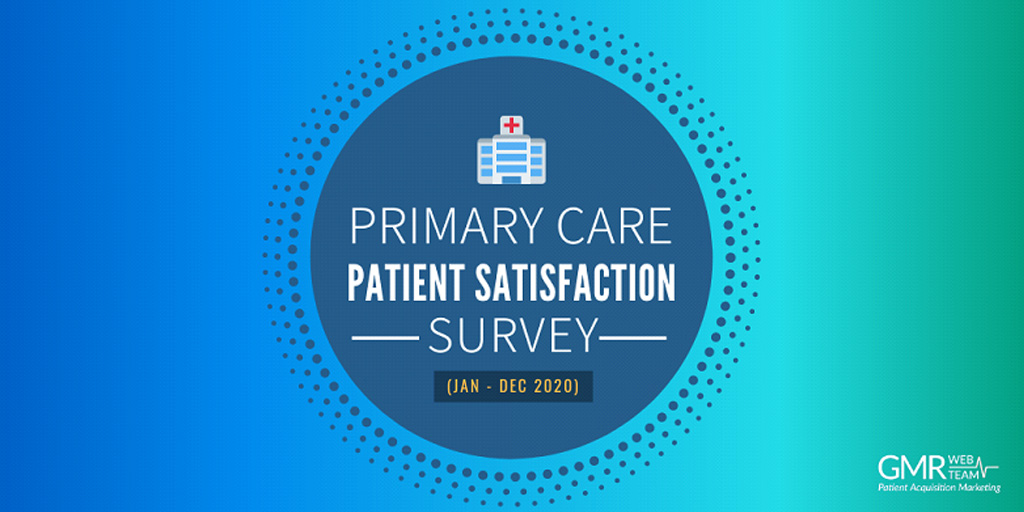
An increase of 6.4 % in positive ratings in 2020 indicates a rise in the overall patient satisfaction level.
Key Takeaways
- 96.8 % of patients gave positive ratings about their visit to primary care physicians in 2020, whereas it was 90.4% in 2019.
- 1.8% rated their experience neutral in 2020, whereas it was 4.2% in 2019.
- Overall, the Net Promoter Score (a measure of patient's loyalty) for physicians is 90.6/100 (Total Sample = 101,381), whereas it was 87.6 /100 in 2019.
-
- 92.6 % of the patients are Promoters (patients who are likely to refer a specific practice/doctor to a friend or family member), up by 2.2% compared to 2019.
- 5.5% of the patients are Passives (patients who are not likely to take any action in referring a specific practice/doctor), whereas it was 6.9% in 2019.
- 1.9% of the patients are Detractors (patients who are likely to deter people from choosing a specific practice/doctor), whereas it was 2.8 % in 2019.
- Excellence, Pleasant, and Thorough were the dominant words used by patients who rated their experience as positive.
Welcome to the GMR Web Team Primary Care Patient Satisfaction Survey (2020)
Since the inception of our first patient satisfaction survey report (January-June 2017), we have seen some changes in the ways patients review their healthcare visit experience, but mostly in how we analyze it. This survey follows on from our first report, comparing the useful insights on reviews and patient satisfaction. The data was taken from our proprietary software RepuGen.
This survey evaluates the Emotions and Opinions of patients for their primary care physicians and helps physicians understand the needs of their patients for developing effective patient-related programs to attract and retain more patients. This will help in developing a stronger bond between patients and physicians, and the patients will become the advocate of their physicians, resulting in more referrals and fueling growth.
How Do Patients Rate Their Visit to Primary Care Center Office Based on Their RepuScore*?
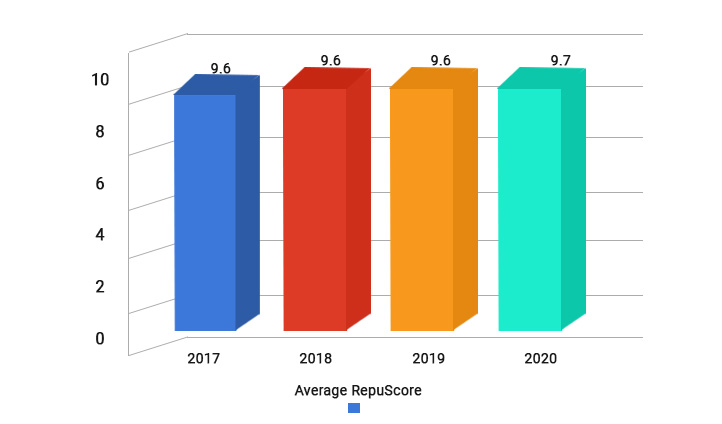
*RepuScore is the score given by patient on a scale of 0 to 10 when asked their likelihood of recommending the physician based on their experience of the last visit. 0 means will not recommend, and 10 means will recommend.
Key Findings
- The Average RepuScore increased to 9.7 in 2020 from 9.6 in 2019
Analysis
- Given that the primary care centers in this study were using GMR Web Team tools to address patient complaints, it is not surprising that the likelihood of recommending the physicians has increased to 9.7 from 9.6 (above the already high levels of the benchmark study)
- This also validates our view that paying more attention to patient experience is the key to getting more recommendations from patients.
All Ratings (Rating Breakdown)
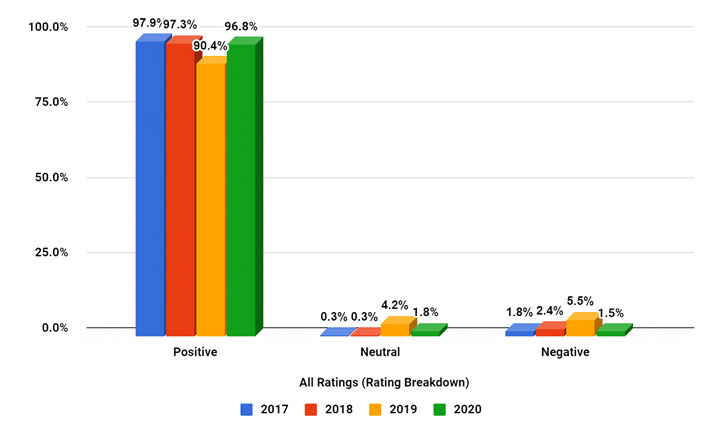
Key Findings
- Consistent with the overall data, more patients rated their experience as positive. The positive reviews increased by 6.4% in 2020 compared to 2019.
- Patients rating their experience neutral decreased by 2.4 %, whereas ones rating as negative decreased by 4.0 % in 2020 as compared to 2019.
Analysis
- More positive ratings suggest that the efforts by primary care centers to address their patients' concerns are helping to improve the patient experience.
- The COVID-19 situation may have some role in reversing the decline of 6.9% in the positive reviews as witnessed in the previous year. This year (2020) showed an almost equal but reverse change in the reviews with an increase of 6.4% in the total positive reviews, indicating an improvement in the primary care services provided.
- This could also be termed as the “Possible Pandemic Effect” wherein:
- Already overwhelmed with the COVID crisis, the providers aimed at easing their patient’s concerns with greater diligence and prompt services, thus resulting in a rise in the overall patient satisfaction level.
- After prolonged lockdowns and minimal social interactions, visiting their primary care providers revived the importance of seeing your primary care doctors for any healthcare concerns. This, in turn, could be one possible factor that drove the level of patient satisfaction to new heights.
- Primary care centers need to focus more on the patient experience and pain points to increase patient satisfaction.
- The decrease in negative ratings can be co-related to the increase in positive reviews to imply that more patients experienced higher levels of satisfaction in 2020 than in 2019.
- Primary care centers must compare their individual scores with the overall numbers to identify areas for improving the patient experience when they visit the office.
Net Promoter Score Breakdown
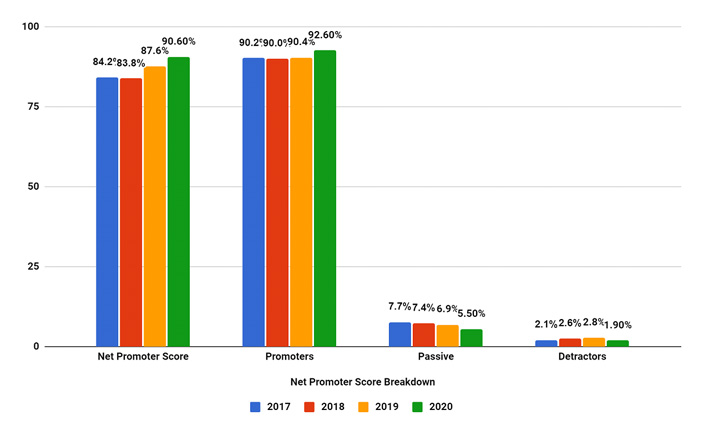
**The Net Promoter Score is an index ranging from -100 to 100 that measures the willingness of customers to recommend a company's products or services to others. It is used as a proxy for gauging the customer's overall satisfaction with a company's product or service and the customer's loyalty to the brand.
Key Findings
- Net Promoter Score saw an increase of 3.0% in 2020 when compared to 2019.
- Percentage of patients who could become promoters increased by 2.2% in 2020 when compared to 2019.
- 1.9 % of patients were not likely to recommend their primary care center as compared to 2.8% in 2019.
Analysis
- The increase in Net Promoter Score in 2020 suggests an increase in patients' loyalty to their primary care center, as well as how increasingly important patient referrals are becoming.
- Overall, 7.4% of patients are not likely to refer people to their primary care physician.
- Primary care centers need to look at their individual scores and compare them with the average number to identify areas where they are doing better and areas where they can improve.
Patient Sentiment Analysis *** after their visit:
*** Patients are asked to explain their reason for rating their visit the way that they did. GMR Web Team analyzes sentiments and its intensity based on the entities and attributes, using an artificial intelligence tool. This gives a better perspective of whether the patient holds a positive or a negative sentiment/opinion towards their provider.
Patient Sentiment Trends
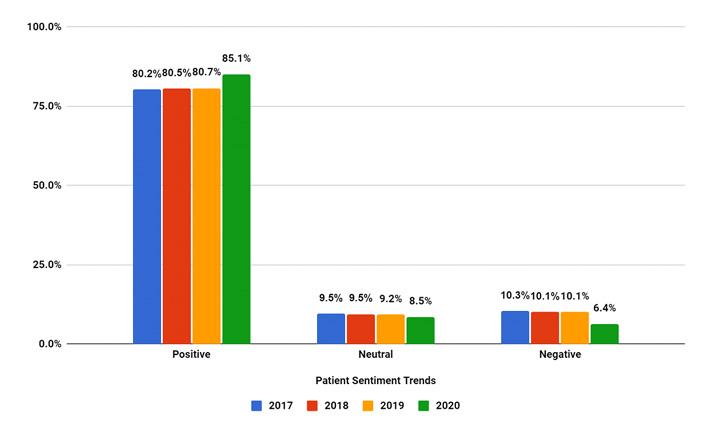
Key Findings
- Positive sentiment saw a significant increase of 4.4 % in 2020 as compared to 2019.
- There was a decrease of 0.7% in neutral sentiment in 2020 compared to the last report (2019).
- Negative sentiment decreased significantly to 6.4% in 2020, from 10.1% in 2019.
Analysis:
- General Inference:
-
- From patient’s POV:
Due to the COVID-19 situation there is a possibility that patients are more responsive and grateful for the primary care services. This sense of gratitude might be triggering the increase in positive sentiment and the decline in negative ones. The people have become more health conscious, seeking treatment options early, thereby enabling prompt resolution.
- From Primary Care Service Providers’ POV
They are providing more prompt and effective services to keep up with the challenges presented by COVID.
- Primary care centers need to identify patients who showed neutral and negative sentiment and address them personally as soon as possible.
- The reason this is so vastly different from the RepuScore is that this relies on artificial intelligence to scan actual patient comments, not just their 0-10 rating.
- Ratings are generally a less accurate way to measure a comment, as the most common ratings are a 10 or 0 – yet most people who rate this high or low are not this happy or dissatisfied.
- You need to measure the context of their comments, which is what this AI sentiment analysis tool does – at about a 3% margin of error.
- This also shows the online review scores aren't always an accurate portrayal of reputation, based on how much the ratings are skewed.
- Note that a negative sentiment doesn't equal an unhappy patient. Taking a comment as a whole, an AI sentiment analysis tool could take a positive rating as negative for something as simple as 'the wait time was too long.'
Entities and Attributes That Highlight Patients’ Sentiments
**** Our AI tool has analyzed the positive and negative entities based on the frequency of the words mentioned below (attributes) used in the comments made by patients.
Key Findings
- Out of a total 42487 comments, 97.7% expressed a positive sentiment, while 2.3% expressed a negative sentiment.
Patient Positive Sentiments
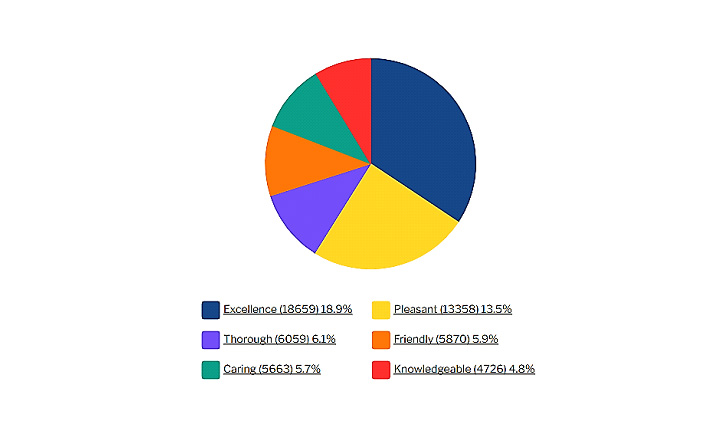
Excellence (18.9%), Pleasant (13.5%) and Thorough (6.1%) were the top 3 positive sentiments expressed by the patients.
Patient Negative Sentiments
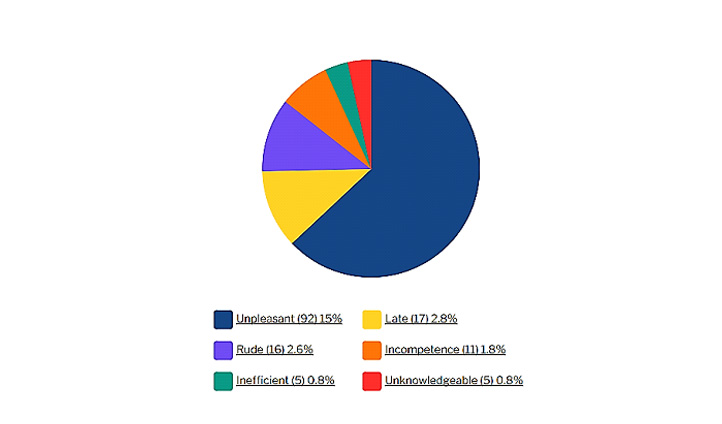
Unpleasant (15%), Late (2.8%) and Rude (2.6%) were the top 3 negative sentiments expressed by the patients.
Analysis:
- Other than the top 3 positive sentiments- friendly, caring and knowledgeable were some other positive attributes expressed in the patient’s comments. Primary care providers need to build up their practice on these positive sentiments to create and sustain greater patient satisfaction.
- Other than the top 3 negative sentiments- incompetence, inefficient and unknowledgeable were some other words used by patients to describe their unsatisfactory experience. The negative sentiments expressed call for the provider’s attention- highlighting areas that need immediate redressal before escalating into a greater cause of dissatisfaction amongst patients.
- Note that a negative sentiment doesn't equal an unhappy patient. Taking a comment as a whole, an AI sentiment analysis tool could take a positive rating as negative for something as simple as 'the wait time was too long.'
About the GMR Web Team Primary Care Patient Satisfaction Survey
- An online survey was conducted from January 2020 through December 2020 among 101,381 patients at primary care centers that are using GMR Web Team service. We included the data of 2019, 2018 and 2017 to show the actual trends over the years.
- The patients were asked to select their likelihood of recommending the physician based on their latest experience on a scale of 0 to 10.
- Patients were asked to explain the reason behind their rating.
- All the information (rating score and comments) was detached from patient and doctor identification to make the report HIPAA* compliant. GMR Web Team cannot backtrack comments or sentiments to link Net Promoter Score or sentiment to any patient or physicians that were used for this report.
*HIPAA - The Health Insurance Portability and Accountability Act, a US law designed to provide privacy standards to protect patients' medical records and other health information provided to health plans, doctors, hospitals and other health care providers.
- Patients were then classified into 3 categories – Promoters, Passives, and Detractors.
-
- Promoters: Patients giving a rating of either 9 or 10 to their physicians were classified as Promoters. They are loyal enthusiasts who will keep referring the physicians to other patients.
- Passives: Patients giving a rating of 6 to 8 to their physician were classified as Passive. They are satisfied but NOT enthusiastic patients who are vulnerable to competitive offerings.
- Detractors - Patients giving a rating of 0 to 5 to their physician were classified as Detractors. They are unhappy patients who can damage the reputation of their physician and impede growth through negative word of mouth.
- All comments were grouped by positive, negative, and neutral ratings.
- GMR Web Team proprietary software RepuGen was used to gauge patient sentiment by group (positive, negative, neutral) and also to gauge the intensity of the sentiment based on their comments about their experience.
- RepuGen was used to analyze word density of comments by the group of patients to identify words used by patients to describe their experience.
Why Is the Primary Care Patient Satisfaction Benchmark Report So Important?
Online reviews and recommendations from existing patients are the best source of new patients for primary care physicians.
- In-depth analyses of patient experience help physicians identify their strengths and weaknesses, giving them the knowledge to make positive organizational changes.
- Understanding the patient sentiment and its intensity provides insight into the patients’ mindsets after they leave the office. Physicians can use the information to improve satisfaction and brand their practice consistent with the positive sentiments generated by their service.
- The density of words extracted from patients’ comments of different groups will help communicate the desired branding effort better.
Suggested Next Steps:
Primary care physicians and family medicine practices should gather patient experience information to better understand patient sentiment, and ultimately improve patient care and satisfaction.
Patient satisfaction data can also be used to attract more patients by:
- Improving online reputation by requesting happy patients to share their information on the internet. Around 70% of prospective patients use online reviews as a first step to finding new doctors.
- Developing an automated referral program that requests happy patients to recommend their doctor or family medicine practice to others.
Contact us at 800-523-7187 or fill out our form to learn how you can start building your patient satisfaction data and how to use it to generate more patients.







